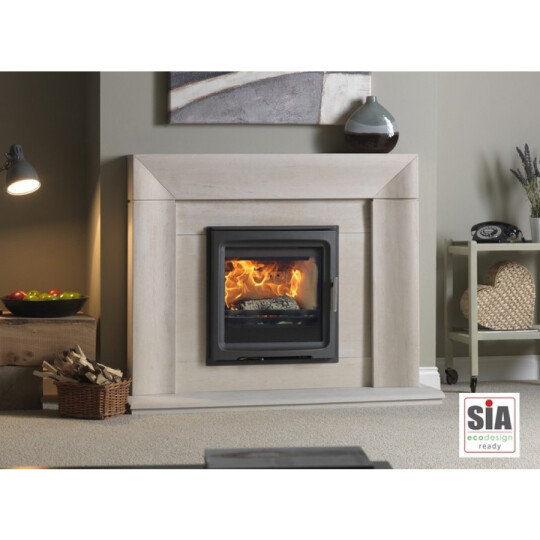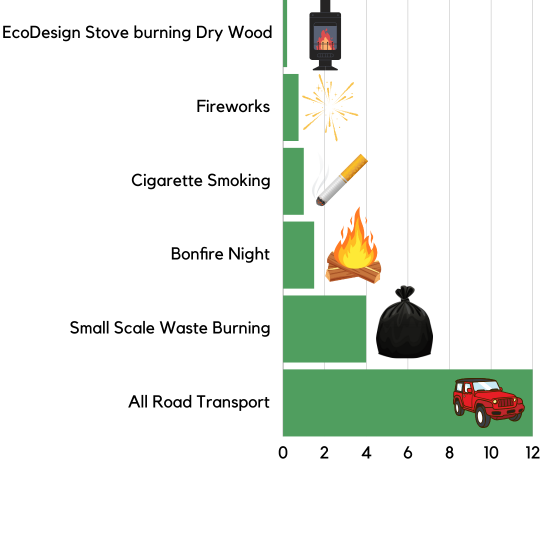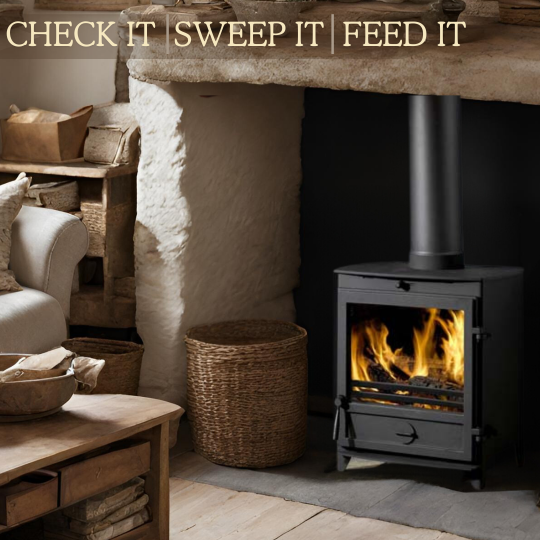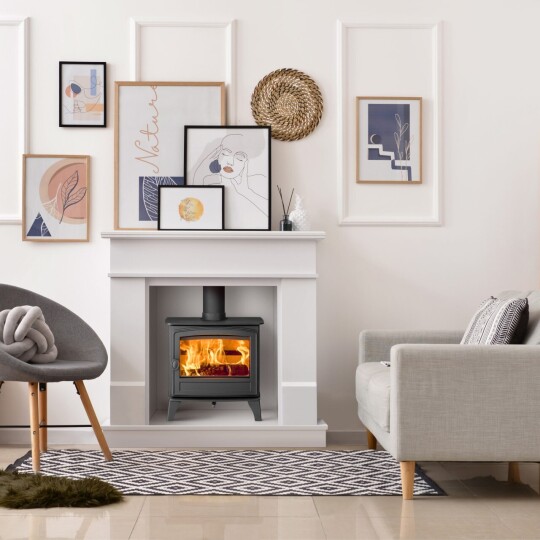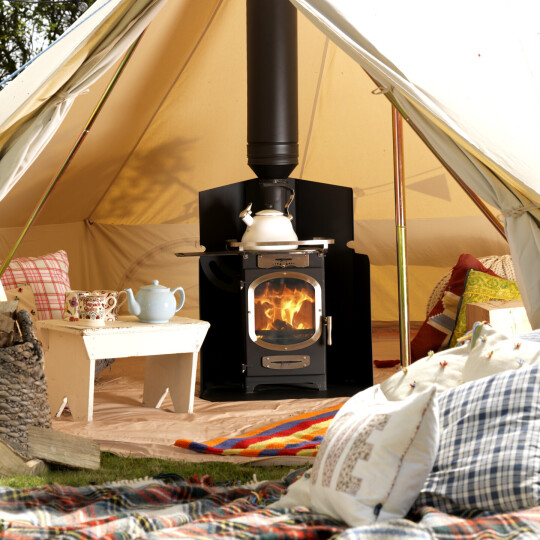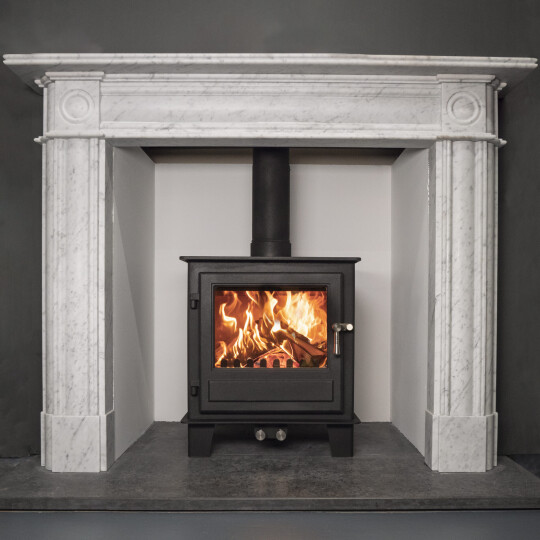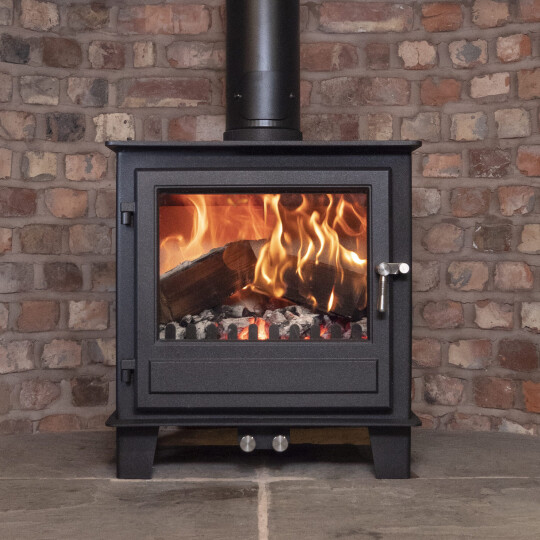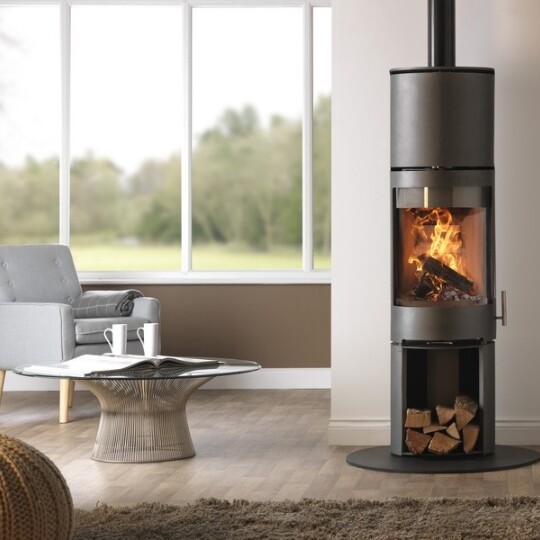FAQs
What size stove will I need?
The most common Frequently Asked Question - The size of stove you’ll need will of course depend on the age of your home, the size of your room, the number of windows in the room, number of external walls, its insulation, how open plan it is, whether there are any stairs coming off it etc. Most stove manufacturers measure stove size in kilowatts (kw). A rough guide is to measure your room in metres then use the formula below: length (m) x width (m) x height (m) / 14. This will give you the KW output required.
Do I really need to line my chimney?
'Do I really need to line my chimney' is a question asked by a lot of our customers. This is the answer! Most chimneys, certainly in older properties, were designed for open fires where you astonishingly lose 80% of the heat up the chimney and only get 20% into the room - as well as having a wicked draught around your ankles. Open fires are what wing-backed chairs were designed for! All of this heat takes up a fair amount of room in your chimney and travels upwards quickly. It's travelling so fast that it doesn't cool and condense until it reaches the top and all the exhaust gases and any nasty tar, creosote and condensates are successfully expelled. This is how an open fire and chimney should work.
When you put a stove or woodburner at the bottom of your chimney, you instantly reverse the ratio. Roughly 80% of the heat comes into the room and only 20% is lost up the chimney. This vastly smaller amount of hot air swirls around your large chamber, moves upwards much more slowly and leaves behind all sorts of sooty deposits which form as tar and creosote on the inside of your chimney, providing much more scope for a chimney fire. It is inevitably going to cool and condense before it reaches the top and the condensation, when mixed with sooty deposits, produces sulphuric acid which eats into the mortar and brickwork of your chamber. Over time this can affect the structural integrity of your chimney or cause minuscule cracks through which fatal carbon monoxide can leak.
By lining your chimney your chamber becomes a smaller and constant size all the way up enabling the smaller amount of heat to rise faster and not condense before it reaches the top. You have recreated your open fire chamber in a smaller version to accommodate the smaller amount of gases! By having a smaller and constantly sized flue, you have also made it much easier to sweep and there is no scope for flammable creosote to collect in any nooks and crannies!
If this isn't enough of an incentive, an open fire draws ferociously (hence the draught and the need for your wing-backed chair) as it has to feed the big chamber. A woodburner or stove cuts off this massive updraught as you are controlling the air intake so you need to reduce the size of your chamber to maintain the status quo of the draw. Imagine drinking a drink through a fat straw and a thin straw.... the thin straw is much faster and easier.
Building regs don't state that you have to line your flue when fitting a woodburner or stove, however they do state that you must be sure that the chimney is in good working order and has been sufficiently maintained. In our view this is a very difficult thing to have long standing peace of mind over! For all the good reasons stated, most, and certainly the conscientious installers will strongly recommend fitting a liner and may even refuse to install your stove without fitting one.
If you are still in doubt as to the need, give your local fire brigade a call - get their view on installing a stove or woodburner without lining the chimney!
What does HETAS mean?
HETAS is the official body recognised by Government to approve biomass and solid fuel heating appliances, fuels and services including the registration of competent installers and servicing businesses. In short, if the company that installs your stove is HETAS registered they should know what they are doing! Go to the HETAS website or have a look at our HETAS (needs link) page
Woodburner or Multifuel stove?
A woodburner or multifuel stove is largely down to personal choice. The main differences are:
- Wood needs a top-down draught and coal needs a bottom up draught. Consider a bonfire in your garden - wood burns well as a bonfire, coal doesn't - it just congeals into an unpleasant mass.
- A woodburner, therefore does not have a grate, the fuel is burnt on a solid floor and the stove will only have top air controls. When you want to 'do the grate' the ash needs to be scooped out of the firebox manually, leaving a layer in the bottom as wood likes to sit in an ashbed.
- A multifuel stove will have a grate and a separate ashpan and sometimes an external riddler. It will also have top and bottom air controls. When you want to 'do the grate' you agitate the riddler and ask your partner or a particularly obedient child to take the ashpan away and empty it outside!
We have 2 stoves at home and only ever burn wood - but have still opted for multifuel stoves for the sheer convenience of having the separate ashpan. Once the fire is lit, we close the bottom air control completely and then regulate our 'top down' draught using the top air controls so that the stove acts as a woodburner and the glass stays nice and clean. It is probably not quite as economical as using a dedicated woodburner - but I am happy to sacrifice that for the convenience of emptying.
How dry does my wood need to be?
One of the most critical factors in wood burning is the moisture content of the wood - take a look at the Burnright website to learn more. This is where wood seasoning comes into play. Freshly cut wood will contain moisture content of around 65-90%. This wood should never be used. Apart from producing very low outputs this wet wood will also generate large amounts of soot and tar, which can potentially lead to chimney fires (as these particles will coat your chimney and will fuel a chimney fire). For best results wood should have a moisture content of less than 20%. The process of removing the excess moisture is called seasoning. Seasoning is air drying the wood and can take up to two years. Wood should be stored in a well ventilated (but covered) structure, outdoors. Your stored wood should have good ventilation above, below and through it. You can buy kiln dried wood but this is not as environmentally friendly as air dried wood.
You can test wood by using a moisture meter. Green Man Stoves sells a simple device for around £35, it is good enough for you to reject a load of wet wood.
There are some obvious signs if you are burning wet wood:
- The fire will be difficult to light and even more difficult to keep going
- There won't be much heat. All you are doing when burning wet wood is essentially boiling water!
- The fire will be very smoky
- Your stove glass will turn black
- You will find your flue will become restricted or blocked with creosote (tar). This is highly dangerous as it is exceedingly flammable and the prime cause of chimney fires.
Do I need to buy and store wood in advance?
If you have a local friendly merchant then you can use him for regular deliveries. Most folk will buy wood and store it in a wood store. This has the advantage of ensuring the wood is dry and conditioned. It is also there when you need it. If you have room, build a wood store, or use space in the shed. Ideally, try to stay one year ahead. That way you will ensure you are only burning well seasoned wood.
How much wood will I need?
We have 2 woodburning stoves and will probably use between 2 and 5 cubic meters of wood this year. Most merchants sell by the load, and of course the amounts and costs can vary.
Where do I find a reliable wood merchant?
We work with Woodgate Sawmills. We recommend them to all our customers, and actually use them ourselves for firewood in our home. They are extremely reliable and provide firewood of a consistently good quality (some providers product quality tails off as the end of the season approaches) You can be sure that firewood from them is going to be perfectly good to burn in your woodburner all year round
Can you supply a stove that I find online?
We are pretty sure we can, just ask!
Why are stoves cheaper on the internet?
A lot of things are cheaper online - we have a showroom, fitters, trained and knowledgeable staff, a reputation for great aftersales service etc. etc. None of which come free. Our business ethos is that we want to provide an excellent service so that you get the best stove for your needs and that it is fitted safely to give you peace of mind about the health of your family. The internet stores just can't offer this level of service. That is why they are cheaper and that is why customers come to us when they actually want some help and good advice.
Please do check out any warranties or guarantees offered online - to our knowledge they all offer shorter warranties and guarantees with more restrictions than you will get from a main dealer.
As mentioned below, it is your choice if you wish to buy a stove from Scotland or East Anglia and have it shipped over here - but don't be surprised if they won't send an engineer from Scotland or East Anglia if the warranty needs servicing.
If I buy a stove online, will you fit it for me?
Reluctantly, and in some cases no! Please just think about it for a moment. We make our living installing stoves and chimney linings. When you ask us to do this, you are asking us to sacrifice any profit we might have made on the stove and then to take on the responsibility for fitting it. If it isn't the right stove for your needs or great quality or something is wrong with it whose fault does the customer think it is?........usually ours!!
Of course, it is your choice if you wish to spend that sort of money on something being shipped from the other end of the country - however, it is unlikely that your supplier will be willing to send an engineer all the way to said other end of the country to service the warranty. If you truly need us to help you fit a new online purchased stove we will - but the fitting charge will have to reflect the increased responsibility of fitting someone else's stove.
Don't forget also that for the first year the responsibility for your stove lies with your retailer, not the manufacturer. It would be much easier to pop into our showroom if you have a problem rather than deal with a large, anonymous warehouse retailer in the depths of East Anglia or Scotland - much more tricky to go and bang on their door!
Can I install a stove in my conservatory?
Yes you can! However occasionally you will have to seek planning permission. This is particularly relevant if you are in an Area of Outstanding Natural Beauty. The answer is to install a Twin Wall system. This is a chimney system which has an inner skin, a densely packed layer of insulation and an outer skin. If you have a brick glazed conservatory you may be able to go straight through the bottom brick section of the conservatory and up the outside (dependant upon how many courses of bricks there are in the bricked section) or you can go through the roof of the conservatory. If this is glazed you will need a glazier to cut a hole in one of the glazed roof panels to accommodate the flue. If your conservatory roof is polycarbonate we are able to cut this hole and for both scenarios you will need a flashing to protect the edges of the glass/polycarbonate which will be siliconed in position and may not look that pretty from below. Some customers choose to replace the panel which the flue goes through to a solid one to avoid this.
Should I buy a cast iron stove or a steel stove?
A cast iron stove will take longer to heat up, but will retain residual heat longer. A steel stove will heat up more quickly, but lose its heat more quickly. Advocates of cast iron will tell you that steel stoves will warp and advocates of steel will tell you that cast iron cracks. In our view, this is not a decision breaker. We have installed some 4000 stoves and in all that time we have had one cast iron stove top crack and one side wall of a steel stove warp. In each case we were able to sort the problem out quickly and easily. If you fall in love with a cast iron stove when you were seeking steel - go for it! and vice versa!
The emphasis has got to be on buying the best quality stove, whether it is cast iron or steel, that your budget can accommodate. We can supply almost any stove, however there are stoves that we feel are poor quality and poor value for money and if this is the case with the stove you choose, please don't be offended if we say so!
What sort of hearth do I need?
Different stoves require different hearth requirements. Before you do anything to your fireplace get us to advise. All too often customers renovate a fireplace and then find they have to alter it again to enable a correct and compliant stove installation.
Can I fit the stove myself?
Yes. You must get it signed off to current building regulations though by the Council and there is a charge for this - sometimes quite a hefty one! Please note - most solid fuel installation problems are DIY installations - it's not just dropping a tube down a chimney!
Is coal smokeless fuel?
No!! Multifuel stoves are not designed to burn it and doing so may invalidate your warranty. Bituminous, house or lump coal burns with long flames which play around and above the throat plate directly onto the underside of the top of your stove which may result in burned out throat plates and cracked top plates. It also creates huge quantities of soot with all the associated blocked flue and black glass issues. Don't do it!!
What should I be doing with my new stove?
We will always give you a 'lesson' in how to use your new stove and how to care for your stove and liner before we leave. We are only a phone call away though, so do call if you want further clarification or just a bit of reassurance that you are 'doing it right!',
DO:
- Do ONLY use quality clean, dry firewood, or smokeless fuel. The stove will give you much more heat and you will avoid chimney problems. Burning unseasoned or wet wood causes creosote to build up in the chimney or flue – this is highly flammable and can cause a chimney fire. Creosote can be very difficult to remove and very costly to rectify. In severe cases the chimney may need re-lining completely. Household waste must not be burnt. Avoid unseasoned or wet wood, treated wood & pallets, painted or preserved wood, house coal. Using any unapproved fuel will invalidate the product warranty.
- Do check your wood is less than 20% moisture inside the log when split. Think about purchasing a digital wood moisture meter – this will enable you to reject a load of ‘seasoned’ firewood if it isn’t less than 20% moisture, or at least avoid a ‘seasoned’ premium on the price!
- Do get your flue swept, checked for blockages and your stove serviced at least annually and always at the end of your burn season. Don’t leave corrosive material inside your flue over the summer. This is a warranty/guarantee requirement. However if your appliance is used continuously or burns either wood and/or bituminous coal, more frequent sweeping is recommended. Only polypropylene brushes of the correct diameter should be used to prevent damage to the inner liner. Chemical cleaners must not be used.
- Do always use a fireguard for children and the infirm.
- Do use the stove gloves and tools provided as needed.
- Do use the top air control (air wash) to help keep the glass clean.
- Do warm up the stove fully on the first loads of fuel before reducing the air controls to a lower position.
- Do keep your stove clean inside and out.
- Do test your carbon monoxide alarm frequently.
What's the best way to light a fire in my new stove?
A great many of our customers are seasoned solid fuel stove users, and some are first time users - Whatever your level of experience, I learn new things all the time, and it is worth just reading this through to see if you pick up any tips. As with all things, there will be a learning curve as you get used to your new stove, and we're here to help if you struggle with anything!
Lighting Your Fire:
- Open all air controls fully.
- Grab two medium size logs which fit inside your firebox with a small gap between them
- Place 3 or 4 bits of kindling in a criss-cross shape bridging the gap
- Pop a lit firelighter into the gap underneath the kindling
- As the kindling burns the larger logs will catch and your fire is self-sustained to get the firebox up to a good combustion temperature
- Leave the fire to burn through and get fully warmed up before reducing the air controls down to a running position.
- If you are only burning wood, try to keep the bottom air vent closed and only control using the top air vent. The stove will use less fuel, give out more heat and keep your glass cleaner.
- Don’t leave the fire unattended whilst warming up. Inadvertent and damaging over-firing can result.
When to re-fuel:
Refuel logs as soon as the flames have burnt out and the logs have turned to crumbling charcoal. Refuel smokeless fuel which has turned to ash all over and heat output is reducing.
What is, and when might I need a CCTV chimney camera inspection
CCTV Camera Inspections tell us if it is safe for you to have a stove installed. Lining a chimney involves hanging a stainless steel chimney liner down your chimney through your house. Before you commit to do this, you need to know your chimney is safe and sound. So that it will:
- Hold the chimney liner without your chimney falling down!
- Prevent poisonous gases from leaking into your home should your chimney liner fail for any reason.
- Keep your chimney separate from your neighbour’s chimney (and vice versa of course!)
For the full picture (haha) visit our CCTV Chimney Camera Inspection page.
Reasons Not to Have a CCTV Camera Inspection - None!! Just because 'you're not dead yet' (we hear this all the time) doesn't mean your chimney is safe. If you can minimise a risk - why wouldn't you? and it isn't just your risk. If something bad happens, someone will be blamed. We minimise our exposure to risk by making sure your installation will be safe, legal and insurable before we start.
Why should I have my stove or woodburner serviced?
As with any appliance or equipment which is in fairly frequent use, it is advisable to have your stove serviced annually to make sure it is safe, working properly and looking good! This may also be a requirement of your house insurance and stove warranty. Green Man Stoves offers a full chimney sweep and stove servicing service which includes:
- Checking your stove glass for any damage, cleaning it and advising if any replacement is needed
- Checking the door seals for tightness and replacing stove rope if necessary
- Checking all movable controls - top and bottom air, riddlers, dampers and adjusting if necessary
- Examining fire cement seals - rejointing if required
- Examining register plate seals and resealing if necessary
- Sweeping full length of flue liner and removing all debris
- Examining body of the stove and respray if necessary
- Inspecting your installation for leaks
- Advising on fuel being used
- Checking any ventilation fitted is clear of obstruction
We hope you have found these answers helpful – If you haven’t found the answer to your question, please call us on 01989 218328 or 01453 753485 or get in touch.

